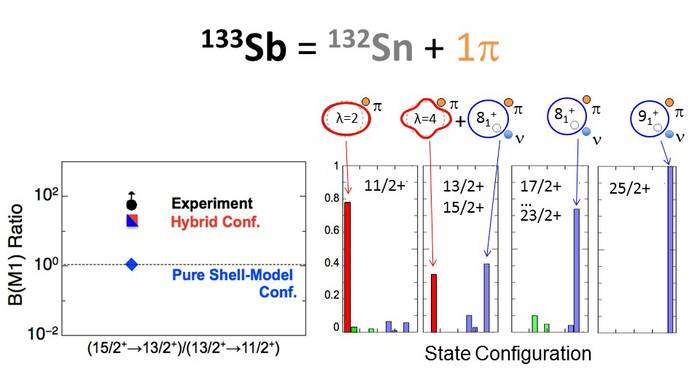The intriguing interplay between collective and single-particle excitations in an exotic nucleus

Nuclear reactions are among the most important processes that drive our Universe. In our Sun nuclear fusion provides the energy for the sun to radiate. In more violent cosmic events neutron capture reactions are at the origin of the creation of the heavy chemical elements. On Earth, nuclear fission provides the energy in nuclear reactors and neutron induced transmutation processes hold the promise of a viable route to nuclear waste treatment. It is thus only understandable that scientists continuously strive to achieve a better understanding of what is going on inside nuclei. Given that nuclei are complex systems composed of many strongly interacting elementary particles this is a formidable task requiring excellent experimental data. A method of choice for the investigation of nuclear structure is the observation of highly energetic electromagnetic gamma radiation emitted in the course of nuclear reactions.
A pan-European collaboration of research teams has recently set up an ideal experimental set-up at the ILL to study the spectrum of gamma rays emitted in the course of nuclear reactions triggered by the capture of slow neutrons. During this so-called EXILL campaign a wealth of data could be accumulated. Using these data the collaboration has now published a fascinating paper on the nature of the nuclear excitations in 133Sb. The work elucidates the interplay between collective and single-particle excitations in nuclei and proposes a quantitative theoretical explanation. It has as such great potential to advance our understanding of nuclear structure.
The nucleus of 133Sb is particular interesting because its immediate neighbor 132Sn is a so-called double magic nuclide. Out of the 133 nucleons that compose the nucleus 133Sb, 132 are nicely wrapped up in a stable core of shells, to which a lone proton is added. The results presented in the paper show the intriguing interplay between collective vibrations of the core and the single particle excitations. Such hybridization phenomena are well known in all branches of physics and may be experienced even in daily life. Imagine the population of a large modern city commuting every day between the center and the suburbs. This highly collective periodic motion is induced by the interaction between the commuters, which resides in the obligation to work together in the center of town. In the nucleus such collective motions show up as oscillating deformations of the core. Now add to this system a tourist from a neighboring town keen on going to the museums. This "particular" individual interacts with the flow of commuters due to a number of constraints, one of them being the opening hours of the museums. Depending on the details of these interactions he or she will enhance to a more or less extended degree the collective flow. In the 133Sb nucleus the added proton experiences a similar situation, i.e. its changes of state cannot be seen in isolation but will be more or less coupled to the deformations of the nuclear core.
More information: G. Bocchi et al. The mutable nature of particle-core excitations with spin in the one-valence-proton nucleus 133Sb, Physics Letters B (2016). DOI: 10.1016/j.physletb.2016.06.065
Journal information: Physics Letters B
Provided by Institut Laue-Langevin



















